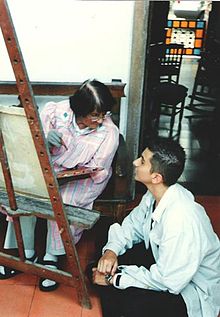Débora Arango
| Débora Arango Pérez | |
|---|---|
 |
|
| Born | November 11, 1907 Medellín, Colombia |
| Died | December 4, 2005 Medellín, Colombia |
| Nationality | Colombian |
| Movement | Figurative Expressionism, Neo-Figuration |
Débora Arango Pérez (November 11, 1907 – December 4, 2005) was a Colombian artist, born in Medellín, Colombia as the daughter of Castor María Arango Díaz and Elvira Pérez. Though she was primarily a painter, Arango also worked in other media, such as ceramics and graphic art. Throughout her career, Arango used her artwork to explore many politically charged and controversial issues, her subjects ranging from nude women to the role of the Roman Catholic Church to dictatorships.
Arango's first exposure to art education was in Medellín, and came at a fairly young age, thirteen years old. From 1920 to 1950, Arango studied plastic arts and painting at various institutions, including the Instituto de Bellas Artes (Medellín, Colombia), "La Esmeralda" (Mexico City, Mexico), and the Escuela Nacional de Bellas Artes. Arango returned to the Instituto de Bellas Artes in 1959 as an instructor.
Eladio Velez and Pedro Nel Gomez were Arango's instructors during her time at the Instituto de Bellas Artes, and it was Pedro Nel Gomez's murals that inspired her early watercolors Arango's watercolors are considered very significant, as they illustrated realities of everyday urban life in a way that had not previously been expressed. While many people were still painting pretty, simple images, Arango explored urban life's depths, and the grittier side of life. It was under the influence of nel Gomez that Arango's work shifted from a traditional style to become more suggestive and meaningful.
Jose Orozco's works, which Arango studied at the Escuela Nacional de Bellas Artes, also significantly affected her, influencing her future techniques and style. In El Tren de la Muerte (The Train of Death), the dead bodies of massacred people are depicted inside a train car; the brush strokes and lines are dramatic and the faces, all unidentifiable, have formed horrific expressions. This is similar to Orozco’s The Trench, which depicts unidentifiable figures engaged in battle; the style of the brush strokes and lines are similar, and Orozco is trying to emphasize the anonymity of revolution and the destruction that it causes. Like Orozco, Arango draws attention to the lives being ruined by a corrupt Colombian government.
...
Wikipedia
